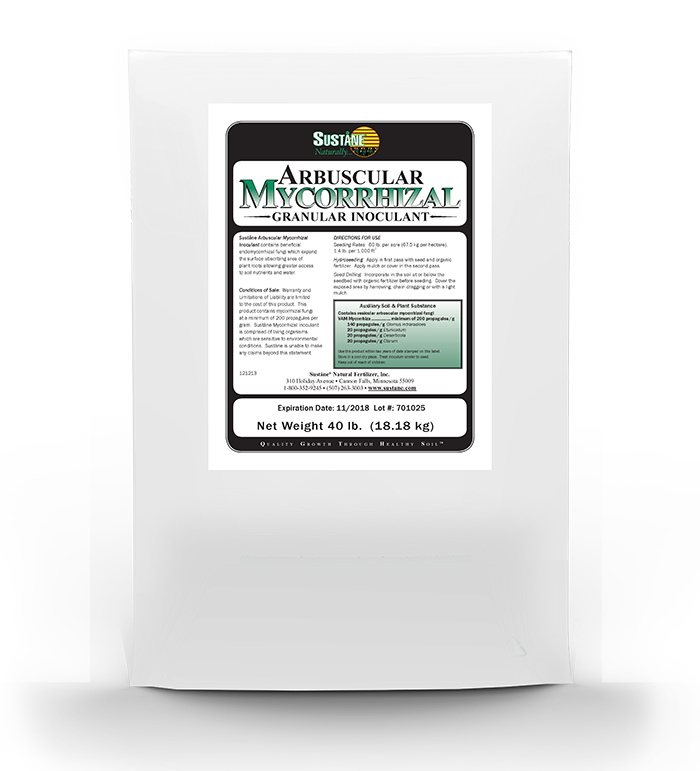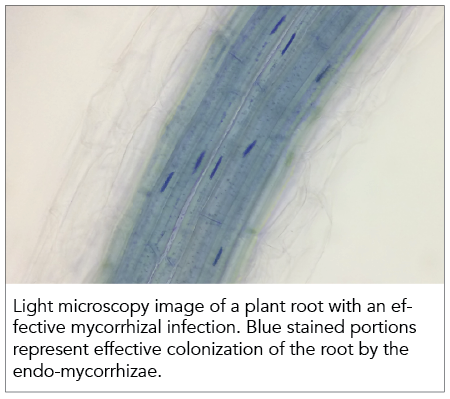
A proprietary blend of four carefully selected Endomycorrhizae species of which 85% of all plants form an association.
Mycorrhizal fungi are living organisms that provide several benefits for their host plant. These organisms are entirely dependent upon their symbiotic relationship for survival and consequently provide a number of services and materials to assure their host plant’s survival and productivity. The host plant provides nourishment to the mycorrhizae through plant root exudates and sugars. While most plants form an association with mycorrhizal fungi, not all plants require mycorrhizae to survive. However, most plants are more vigorous and more resistant to plant senescence when in the presence of symbiotic mycorrhizae.
Efficient use of water and plant nutrients: Upon colonization of the host plant, mycorrhizae begin to significantly increase the plant’s access to the soil resource pool by extending (literally miles of additional) microfilaments known as hyphae throughout the rhizosphere (root zone). These threadlike structures extract both soil moisture and plant nutrients from an enlarged area and from minute sites that are inaccessible to bare roots drawing water and nutrients from a volume of soil that is 40 to 50 times greater than what the plant alone can access.
Enhanced Plant Immune and Defense System: Mycorrhizae provide access to soil nutrients such as phosphorous, calcium, sulfur, ammoniacal nitrogen and zinc. These specific plant nutrients are key to the plant’s formation of immuno-defense compounds such as alkaloids, terpenes phenols, and flavinoids. When these compounds are present at sufficient levels in a plant it has the capacity to fend off pests and pathogens.
Improved Soil Structure: As mycorrhizal hyphae develop they excrete a glue-like substance called “glomalin”. Glomalin is an important substance found in well-aggregated soils that creates additional porosity, which allows for increased movement of air, water, and beneficial soil organisms throughout the soil profile. Many of the common root pathogens actually prefer waterlogged and compacted soils (anaerobic conditions). Conversely, an oxygen-rich (aerobic) soil environment created by well-aggregated soils favors many of the beneficial microorganisms that assist plants in soil mineralization (of plant nutrients) and help in the suppression of plant and soil pathogens.
Plants That Benefit From Suståne Arbuscular Mycorrhizal Inoculant
Include most flower, annuals and perennials; forage crops (alfalfa, clover, corn, cowpea, millet and Sudangrass); cereal grains such as barley, corn, rice, soybeans, sunflowers and wheat; herbs, ornamental crops, trees, bushes, fruit and nut trees and vine crops; turfgrasses and groundcovers (bentgrass, bluegrass, buffalograss, bermudagrass, fescues, dichondra, ryegrass, vetch and vinca); and many tree species including alder, beach, birch, black locust, chestnut, cottonwood, date palm, douglas fir, eucalyptus, fir, hemlock, larch, oak, pecan, pine, poplar, spruce and walnut.
Remember that mycorrhizae require (light) coverage or soil incorporation and should form an association with living plant roots within days after incorporation.
Apply mycorrhizae with the first pass with seed and Suståne organic fertilizer (e.g. 4-6-4, 5-2-4, 6-1-3, or 8-2-4). Follow first pass application with mulch or other cover.
Rates
Apply 60 lb. per acre
Apply 7 g per 1 m2
Coverage
1.4 lb. covers 1,000 ft2 @ 60 lb. per acre
700 g covers 100 m2 @ 70 kg per hectare
Hydroseeding: Alternately the mycorrhizae, seed, organic fertilizer and hydro mulch may be tank mixed and applied simultaneously. Be certain to provide mycorrhizae cover from direct sunlight.
Seed Drilling: Incorporate mycorrhizae into the soil at or below seed placement.
Broadcast and Till: Uniformly apply organic fertilizer and mycorrhizae over the seedbed before seeding. Broadcast seed and cover the seeded area by light incorporation or surface tillage, or apply a light mulch layer over the seed and mycorrhizae.

Arbuscular Mycorrhizal Inoculant
Auxiliary Soil and Plant Substance
Non-Plant Food
|
Contains vesicular arbuscular mycorrhizal fungi
Endo-Mycorrhizae Inoculant Rhizophagus irregularis Rhizophagus clarus Septoglomus deserticola Claroideoglomus etunicatum |
200 spores/g 140 spores/g 20 spores/g 20 spores/g 20 spores/g |

